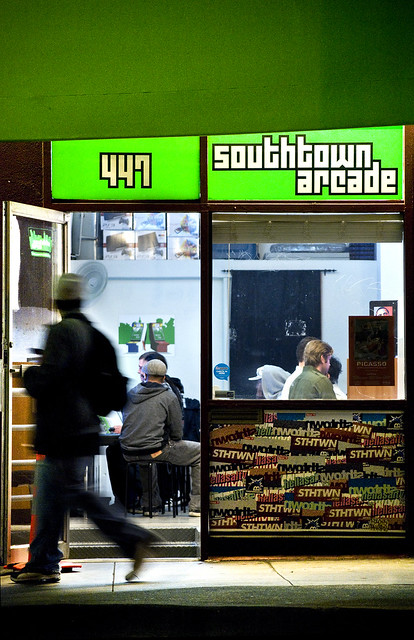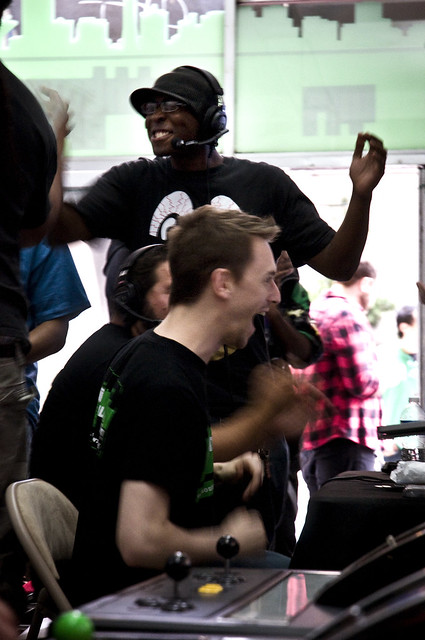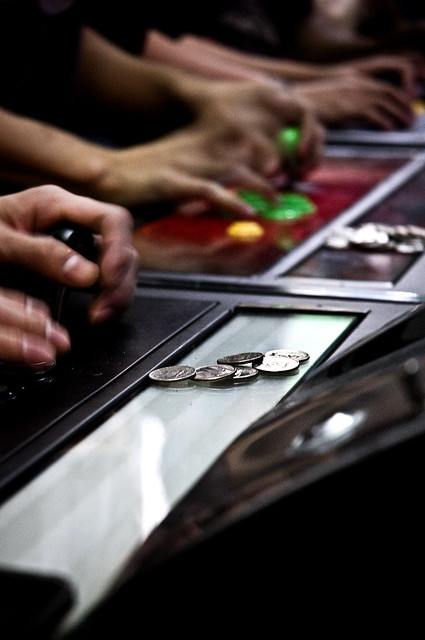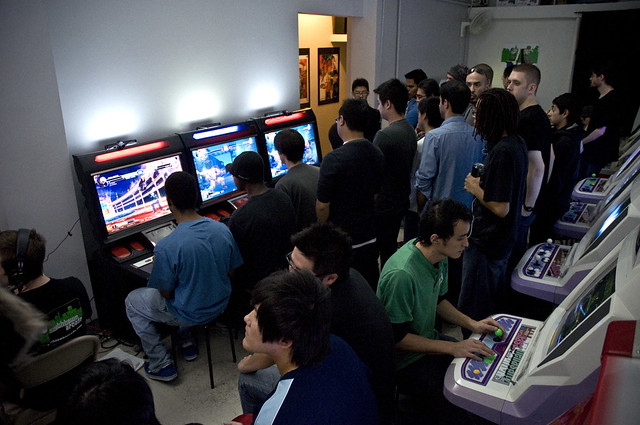By Erin Bates
While Facebook continues to be the most popular Internet pastime among college students—newsfeeds aren’t always compelling for everyone. San Francisco State University student Jeremy Hedman prefers spending his free time submerged for hours in a war-torn portion of the Milky Way galaxy of the future.
Starcraft II: Wings of Liberty is a real-time outer space strategy game for PC. The 2010 game, similar to its 1998 predecessor, Starcraft: Brood Wars, features three military races that the player can command. The Zerg, an alien insectoid race, the Terrans, the human colonists from earth, and the Protoss, a humanoid psionic alien race with advanced technology.
The strategic play and thrill of winning is what Hedman says keeps him playing, coordinating and dedicated to the Collegiate Starleague, which is a network of competing teams from American universities across the nation.

The rise of competitive gaming
Released by RPG giant Blizzard Entertainment in 1998, the first installment of Starcraft became an instant sensation in South Korea. Categorized as a real-time strategy game, or RTS, fans of Warcraft had something new and exciting to play. In South Korea, home to numerous cyber cafes, gamers flocked to Starcraft for its balanced units, creative storyline, innovative gameplay and impressive visuals. By 2002, a professional circuit of competitive play had emerged in the country, and with it a profitable market complete with idolized star players. The gaming world had never known such a sensation before this. South Korean companies such as Samsung, SK Telecom and KT sponsored teams, much like pro-surfers and skaters gain sponsorship from clothing companies in the States. Brood Wars successfully elevated video gaming to a new level competitively, culturally and in business terms. Console games like Halo or Call of Duty now allow for online play and have their own pro players, undoubtedly inspired by the success of competitive PC gaming.

Despite success in Korea, the gaming-mania has yet to have such a strong reception in the United States. The Major League Gaming Association also formed in North America in 2002, but with much less of a widespread reaction. Still, a core American audience had developed. In 2009, a Princeton student founded the Collegiate Starleague, which now spans across the nation. West coast teams now reside at every UC campus and most CSU campuses. Hedman coordinates the tournaments for the Starleague team at SFSU, which is currently ranked 6th out of the ten teams in its division. UC Berkeley is currently undefeated and ranked number one in their division, followed closely by Stanford and UC Davis.
The Collegiate Starleague made the switch from Brood Wars to Wings of Liberty last season. The 2010 release of the game was well received in America. It has been critically acclaimed as one of the best RTS games ever. Major Korean gaming channels continue to broadcast Brood Wars tournaments. However, due to legal issues with the Korean e-Sports Players Association, known as KeSPA, Blizzard Entertainment has found, after nearly three years of negotiations, that KeSPA is unwilling to compromise in sharing profits made by competitive Starcraft play. Due to these legal concerns, one of two Korean gaming channels, Ongamenet, has not agreed to the new terms required to broadcast Wings of Liberty tournaments.
Arcade Renaissance
While Southern California has been and continues to be the national stronghold for gaming, interest in the Bay Area continues to grow. Due to its status as a major metropolitan city of the west coast and its proximity to the technology industry in Silicon Valley, San Francisco attracts large gaming tournaments, events and release parties.
A recent resurgence in the arcade gaming scene right out of 1980s is visible at the SFSU campus. The bottom floor of the Cesar Chavez Center is flooded with gamers during lunchtime hours. Fighting games such as Street Fighter IV, King of Fighters and Marvel vs. Capcom III reign supreme. With only three arcades in San Francisco, the arcade scene in the city is very close-knit, which is what gave owners of the four-month-old Southland Arcade the confidence in opening their own gaming hub.

SFSU alumnus Art Angulo, along with friends Simon Truong and Cameron Berkenpas would regularly meet up to play console fighting games at their San Francisco homes. Angulo had been collecting handy cabs, the cabinets that resemble old school arcade machines, but instead hook up to personal consoles and display gameplay on a large screen, for a few years.
“He was paying to keep them in storage, and we thought why are we wasting these? Why aren’t we using them to play? The only issue was having enough space for the large machines. That’s when we realized it might be a good idea to open up our own arcade,” says Truong.
The three quietly opened the Southland Arcade, which still has yet to have an official grand opening, in June. With enough like-minded friends and acquaintances to sustain a steady flow of daily patrons, the small arcade on Stockton Street has also been successful in hosting tournaments on a biweekly basis. Their King of Fighters and Street Fighter IV tournaments are live-streamed on Twitch.tv/iplaywinner, where they average about 8 thousand unique viewers.
“When I saw the numbers, I realized that other people really care about this stuff. At the end of the day, it’s great to know that damn, they are really into what we’re broadcasting,” Angulo says.
Because numerous San Francisco arcades have opened and closed in recent years, friends of Angulo were skeptical when he told them he wanted to open Southland Arcade.
“I told him he was crazy,” says Angulo’s longtime friend and fellow gamer, Chris Fields. Fields works at SFSU’s campus facilities in the downtown extension, and in his spare time he plays fighting games. “We went through the Dark Ages of arcade play, where it was no longer cool to play in an arcade. Console systems came out and everyone had their own at home. Things are finally picking up again, but I still thought he was crazy to open one,” Fields says.
Gaming consoles provide excellent online gaming experiences for Call of Duty, Halo and other games, however due to lagging and bad connections, fighter games don’t yet translate so well to online play.
“One bad connection or lag can just destroy a match for you because each frame is so important in fighting games. Muscle memory is key in these games, so online play just doesn’t do them justice at this point. This is the reason having an arcade is so vital to the growth of our scene,” explains Angulo.
Looking forward: The future of competitive gaming
Competitive video gaming isn’t comparable in scope and popularity to other American entertainment staples, such as football or baseball, even in Korea. “In Korea, I’d compare it more to pro-wrestling’s popularity here in the U.S.,” says Hedman. However, he, and many others in the gaming community, foresees a conFighter IV tournaments are live-streamed on Twitch.tv/iplaywinner, where they average about 8 thousand unique viewers.
“When I saw the numbers, I realized that other people really care about this stuff. At the end of the day, it’s great to know that damn, they are really into what we’re broadcasting,” Angulo says.
Because numerous San Francisco arcades have opened and closed in recent years, friends of Angulo were skeptical when he told them he wanted to open Southland Arcade.
“I told him he was crazy,” says Angulo’s longtime friend and fellow gamer, Chris Fields. Fields works at SFSU’s campus facilities in the downtown extension, and in his spare time he plays fighting games. “We went through the Dark Ages of arcade play, where it was no longer cool to play in an arcade. Console systems came out and everyone had their own at home. Things are finally picking up again, but I still thought he was crazy to open one,” Fields says.

Gaming consoles provide excellent online gaming experiences for Call of Duty, Halo and other games, however due to lagging and bad connections, fighter games don’t yet translate so well to online play.
“One bad connection or lag can just destroy a match for you because each frame is so important in fighting games. Muscle memory is key in these games, so online play just doesn’t do them justice at this point. This is the reason having an arcade is so vital to the growth of our scene,” explains Angulo.
tinued rise in interest surrounding gaming as both a personal hobby and a spectator’s sport.
Fighter games seem to need more arcades to gain players and opportunities to compete at a higher level. To put it in perspective, the annual Las Vegas event Evolution is the mecca of professional fighter game tournaments. The winner of that tournament is awarded $10,000. Compare that to MGL Starcraft tournaments, where the top prize goes for $50,000.
“Right now it’s obviously a far less profitable professional field to enter than Starcraft,” Angulo says. “But if the resurgence of fighter games, which I credit to the release of Street Fighter IV, continues, I hope that the arcade scene will also expand. If more kids are able to compete that way, then that could really turn the tables.”

“The best part about the future of gaming is how many people still don’t know about it, which means we have such a large audience that hasn’t been tapped into,” says pro Halo player Lee Santos, who is more commonly known by his gamer tag, twylight.
Gaming is one of the newest forms of entertainment, which gives it a lot of room to grow technologically, developmentally and as a profitable industry. As children grow up in an increasingly gamer-friendly environment, it will rise in popularity by virtue of the fact that it will be seen as socially acceptable, asserts Richie Heinz, who professionally plays Halo Reach for Team Dynasty. Hedman mirrored this sentiment, citing the change he’s seen in reactions to his own passion for Starcraft. “It’s moving away from the stereotypical vision of a gamer as some pale nerd locked up in a dark basement with his computer,” says Hedman. “Nowadays it’s more like, wow that person is awesome AND plays video games. It doesn’t have to be the single defining characteristic of your personality.”


slot machines • Nov 1, 2013 at 2:42 am
I am in fact happy to read this website posts which contains
lots of valuable information, thanks for providing these data.
Riot Points • Jun 24, 2013 at 1:59 am
Hello would you mind letting me know which webhost you’re using? I’ve loaded your blog in 3 different internet
browsers and I must say this blog loads a lot quicker then most.
Can you recommend a good hosting provider at a fair price?
Thank you, I appreciate it!